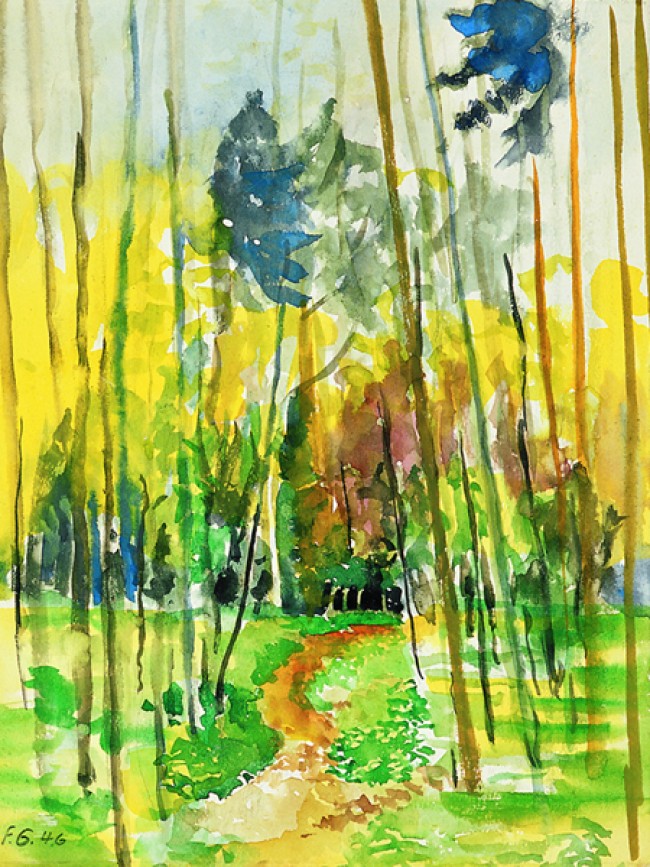Kleiner Bremgartenwald, 1946
Aquarell auf Bütten auf Karton aufgelegt
Watercolour on Bütten mounted on cardboard
23.3 x 18 cm
Besitz des Künstlers
Collection of the artist
© Franz Gertsch
Franz Gertsch
1950 and 1960: Sketches and drawings relating to “Tristan Bärmann”
17.10.2009 – 04.12.2009
An exhibition curated by Rainer Michael Mason in the museum's cabinet with ball point pen sketches and pen and ink drawings relating to the artist book "Tristan Bärmann" (1962). The exhibition with loans from the private collection of Franz Gertsch and Maria Gertsch-Meer includes 46 works on paper and the artist book.
The selection of drawings by Franz Gertsch shown here encompasses two very different groups documenting the artistic approach of a young man, but his styleat the age of twenty and then at thirtyis still developing and pursues different objectives.
The small suite of quick sketches drawn with a blue ball point pen on the pages of a small pocket-sized sketchbook date from Franz Gertsch’s second stay in Paris when he, just released from the military, traveled to the Seine in the spring of 1950. With gentle and vibrating gestures of the wrist he recorded the summary indications of memory drawings. The first two sketchbook pages lead us to the two adult figures from Leonardo da Vinci’s renowned (and famously interpreted by Sigmund Freud) painting, “The Virgin and Child with St. Anne (1508–1510) in the Louvre. After looking down a path past a tree, Franz Gertsch also outlined, perhaps somewhat surreptitiously but persistentlyin the tree-lines park streets?the silhouette of a Latvian girlfriend whom he invited to an outing to Fontainebleau (the Palace of Fontainebleau was built by King Francis I, the one-time owner of Leonardo’s oil painting now located in the Louvre).
A word must be said about the writing instrument employed by Gertsch, the ball point pen. We owe its technical development to László József Biró (1899–1985), an Argentinean from Hungary who applied for the patent in 1944: the British designation “biro still refers to him. The first model was sold by the Reynolds Company in New York in October 1945. This pen was first marketed in France in the early nineteen fifties. The French patent for the “Bic Cristal goes back to 1950. Franz Gertsch was therefore one of the very first artists to make use of the ball point pen.
The other suite of drawings, executed in pen and ink, can be dated to 1960. At that time, Franz Gertsch was preparing the prints for the last of his four artist’s books, “Tristan Bärmann, which was printed in Burgdorf in 1962 (the first book, “This und Weit, was published in September 1950).
Franz Gertsch worked on “Tristan Bärmann while he was separating from his first wife. It is a fairy tale in twenty quarto format woodcuts with a narrative reminiscent of a venerable chronicle that the artist himself meticulously modeled after ancient Chinese literature (Franz Gertsch was then also reading the German Romantics). Because the image very naturally seemed “just as important as the text, he made numerous preliminary studies. Those which were to be cut in wood are marked in the exhibition with a black pointer.
These “briskly drawn works unfold intense features and distinctive black strokes that simultaneously recall from afar the Chinese paintings with which Franz Gertsch regularly occupied himself. They feature a type of expressionism, if not even a somewhat wild coarseness which is somewhat surprising, even though the artist was unfamiliar with German expressionist prints at that time. Transferred to pear wood, these drawings would experience a permutation and refinement to a certain extent while being cut. “You cannot cut a line, people told Franz Gertsch at that time who then pointed to the linear woodcuts of Aristide Maillol’s “Daphnis et Chloé (1937).
The portrayals address all sorts of occurrences: a thatched-roof house between trees, encounters at the fountain and around the table, seascapes, the inner worlds of the library and going to sleep, the affectionate embraces of a couple and, naturally, the appearance of the bear…
(text: Rainer Michael Mason)

